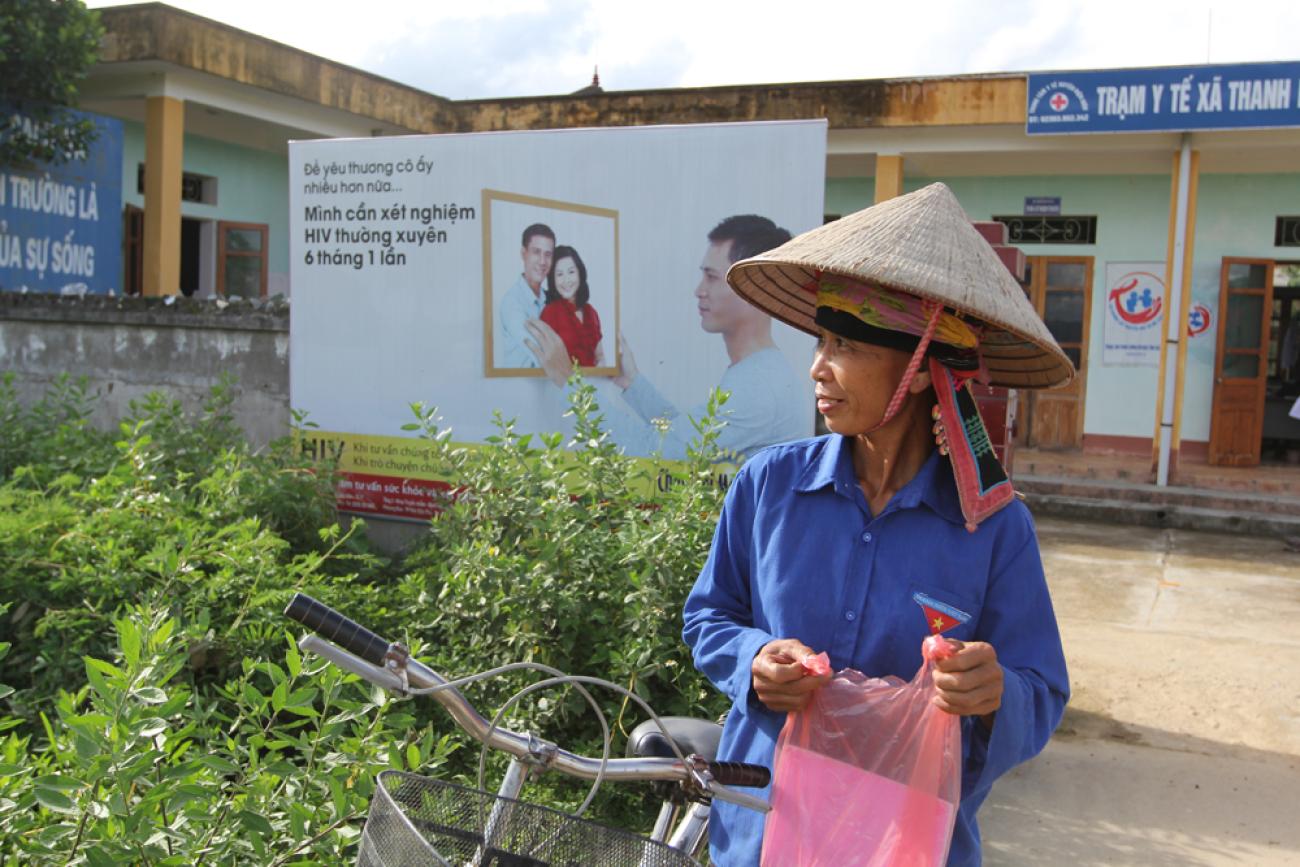The lush green hilly north-western province of Dien Bien is a home for Mrs. Lo Thi Hoa, a Thai ethnic minority woman. Few years ago, squeezing time between cycling for four hours to pick her husband’s HIV antiretroviral (ARV) medicines at the district hospital and taking care of daily house chores were her monthly struggles. Situation altered when Treatment 2.0 Initiative brought HIV testing and treatment to her commune in August 2012. She was tested HIV positive at her commune health station and enrolled in treatment at the district hospital timely. After three months of problem-free care, she was then referred back to her commune health station for monthly ARV re-fills and health check-ups.
ARVs are now made available only few minutes away from home. Mrs. Hoa now well spent her days on feeding her poultry and working on the paddy rice field productively as main source of income for the family. “I no longer have to spend the whole morning cycling to and from the district hospital. This gave me more time for doing the necessary work or rest at home. I also talked to some neighbours who are at higher risk and encouraged them to do a HIV test because it’s very convenient, you only go to the commune health station. I have gained a lot of weight and strength since I started ARV treatment.” said Mrs. Hoa.
Enjoying the convenience of receiving HIV care and treatment much nearer to home, Mrs. Hoa also felt more assured and welcoming to see familiar faces of the health workers at the commune health station. She could also chat with her commune fellows on the way to or when there was queuing at the commune health station. Mrs. Hoa is now optimistic that she and her husband will be able to take good care of themselves if they can continue to be on HIV treatment and thus enjoy good health.
To encourage earlier HIV diagnosis and initiation into treatment, the Ministry of Health’s Viet Nam Authority for HIV/AIDS Control (VAAC) has been an early adopter of the WHO-UNAIDS “Treatment 2.0” initiative, which decentralizes HIV testing and counselling to commune health stations. It focuses on five pillars including optimizing the use of ARVs, providing more points of care diagnosis, reducing costs, adapting delivery systems and mobilizing communities. Village healthcare workers and People Living with HIV (PLHIV) self-help group members were mobilized to motivate key populations to take commune-level HIV testing and treatment. The pilot programme was launched in Dien Bien and Can Tho in 2012, then expanded to more mountainous areas with middle to high HIV prevalence.
Progress of the initiative has been remarkable and sustained. The initiative in Dien Bien province expanded fivefold from 12 communes in 2012 to 63 communes in 2018, benefiting 1,217 PLHIV receiving ART at commune health stations in total. It effectively transferred one-third of HIV services to commune health stations. People received their diagnoses sooner after HIV infection at commune level. Time gap from receiving HIV testing results to initiating treatment has been shortened from more than 150 days to 28 days. The drop-out rate was low, only 4.1% among 926 PLHIV did not retain in HIV care after being transferred from district out-patient clinics to commune health stations over the 6 years of implementation in Dien Bien.
Success of the initiative and mounting demands for commune-level HIV health services led the government to expedite HIV healthcare availability at grassroot level. Soon after the pilot programme, HIV services were officially mainstreamed at commune health stations with specific functions and tasks as regulated in the Ministry of Health’s Circular No. 33/2015HIV. The decentralized approach of health services has been institutionalized. The efforts significantly improve long term access to timely, convenient and friendly HIV care for people who, like Mrs. Hoa’s family, live far away from district level HIV clinic.
WHO and UNAIDS will continue to provide guidance and support to promote the delivery of friendly and affordable HIV services closer to the communities in need as part of efforts toward achieving the end of AIDS as a public health threat, Universal Health Coverage and the Sustainable Development Goals in Viet Nam.
* This contribution story contains excerpts from the final draft of the “Evaluation Report, Treatment 2.0 Pilot, Dien Bien & Can THo Provinces, Viet Nam” that was co-produced by the Ministry of Health/VAAC, the Hanoi School of Public Health, with support from UNAIDS and WHO.



